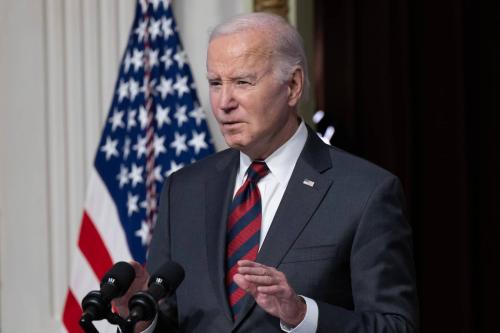When Gross Domestic Product (GDP) growth data for the third quarter of 2020 is released on October 29, it will almost certainly break records. Many analysts project growth over 30 percent at an annual rate – roughly twice as high as any quarterly growth rate since World War II.
Yet despite this phenomenal-sounding growth, the economy will still be in a considerable hole, is actually slowing down, and presents a strong case for concern. Some basic math and data can help pierce through the mirage.
One reason 30 percent growth doesn’t mean the economy is healed stems from how percentage changes work when going down and then up. If you own a stock priced at $100 and it drops 30 percent, it is now worth $70. If it gains back 30 percent, it is then worth $91 (the gain is just $21 because 30 percent of 70 is 21). In the same manner, the large drop in output in the second quarter followed by similar sized increases in the third quarter will still leave a large hole. Even if GDP growth is 30 percent at an annual rate in the third quarter, output will still be more than 4 percent below its level at the end of 2019, which is more than the farthest the economy ever was from its prior peak in the Great Recession.
In addition, in the United States, we typically report growth numbers at an annualized rate. This way of reporting tells you how much the economy would grow or shrink if it kept up that pace for a full year. When there are huge swings up or down (like now) that can be a bit misleading. It made the drop in the second quarter seem larger than it was, and now makes the rebound seem larger as well.
It is also important to recognize that rapid third quarter growth does not mean the economy has strong momentum now. Third quarter growth measures the average level of output in July through September compared to the average in April through June. The very low level of output in April and May set a low baseline, meaning almost any bounce back at all would generate a huge growth rate for the third quarter.
One way to see how much of third quarter GDP growth comes from earlier in the year is to look at the growth in hours worked. Hours worked are often a good proxy for GDP growth, and grew by 25% at an annual rate between the second and third quarters. When looking at the monthly hours worked compared to the quarterly average (used to generate the quarterly growth rate), it is clear that the second quarter average is held down by the low April level, and in fact much of the growth that lifts the third quarter above the second actually came due to the rapid rebound in May and June. In fact, when calculating the growth rate, well over half of the growth comes from May and June. Had hours worked simply stayed at the June level throughout the third quarter, the third quarter growth rate would still be 15% at an annual rate.

Other evidence also demonstrates that the rebound in the economy has been slowing down over the late summer and into the fall. For each month from June to August, personal consumption growth was slower than in the month before. The same was true of retail sales through the summer, though it rebounded slightly in September. The Chicago Federal Reserve National Economic Activity Index, which pulls together over 80 data series from consumption to employment to production indicated that growth in August was the slowest it has been since the economy began to recover in May.
This slower growth is problematic given the huge hole in employment. Employment in the United States is still more than 10 million jobs below its level in February. Job growth, which broke records in June with almost 4.8 million jobs gained, slowed to 1.8 million jobs gained in July, 1.5 million in August, down to 660,000 jobs gained in September. If job growth continues to slow, it will take years to bring the economy back to its level of employment before the COVID recession. Job growth certainly does not look like a “V” anymore.

In many ways, the slowing job growth is not a surprise. Many of the jobs gained over the early summer stemmed from rehiring workers who had been on temporary layoff. In April, 78 percent of the unemployed considered themselves on temporary layoff; that is down to 37 percent in September. Re-employing a worker from temporary layoff is much easier than matching an unemployed worker to a new firm. The number of individuals who say they are on permanent layoff has also grown considerably, from 1.5 million in March to 3.8 million in September. This rise in permanent layoffs is unusually swift. In the first six months of the Great Recession, the number of permanent layoffs grew just half a million. Furthermore, research suggests people overestimate the likelihood of re-employment and each month they are out of work reduces the chances their layoff is in fact temporary. As time passes, improvements in the labor market will become harder.

The number of unemployed actually understates the problem as millions of individuals have left the labor force. Many rejoined over the summer, but the labor force is still more than four million workers smaller than it was prior to the crisis, and it contracted in September, a disturbing stall in momentum.
Even as the economy was growing, there was evidence of extreme distress amongst families. Lines at foodbanks have shocked many. Surveys suggest surges in food insecurity. Reductions in employment, secondary incomes, tips, and gig work have left many families on the brink. Over 2.4 million workers have been unemployed for more than 27 weeks, a number that is sharply increasing and demonstrating extreme hardships for many households.
These indicators suggest the economy needs more help. First, it is essential to control the virus. Many sections of the economy simply cannot restart until there is greater safety and better confidence in the safety of workers and consumers. In addition, the economy will continue to need fiscal support. The unemployed need more financial aid. Small firms – especially those in heavily impacted sectors – simply cannot survive without assistance. State and local governments are increasingly laying off workers as their budgets are under extreme stress. Smart fiscal policy can help keep the recession from turning into an even longer and more painful downturn than it already is.
The flashy GDP growth number for the third quarter is more a statistical quirk and reflection of the sharp dive and subsequent bounce in the spring, not an indication of current momentum. We cannot count on the economy to heal itself, it will take direct action.




Commentary
Don’t let flashy 3rd quarter GDP growth fool you, the economy is still in a big hole
October 26, 2020